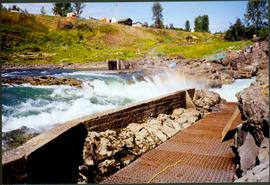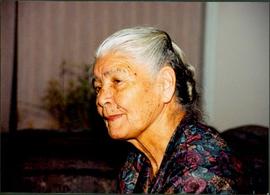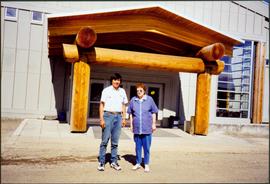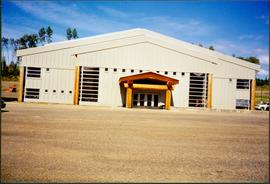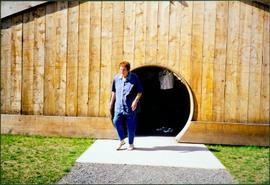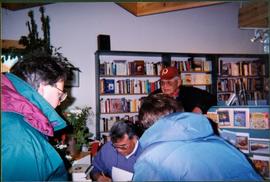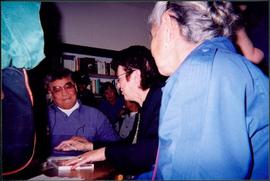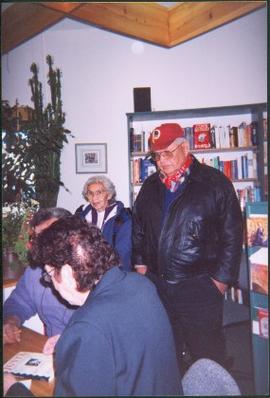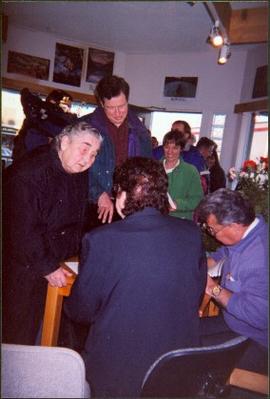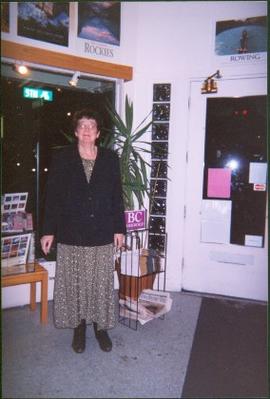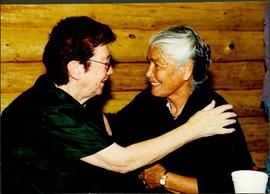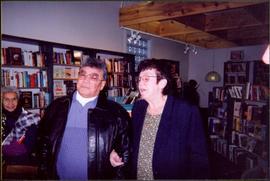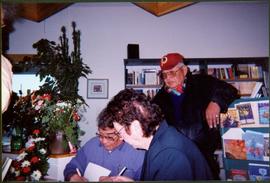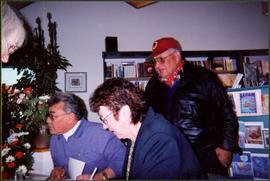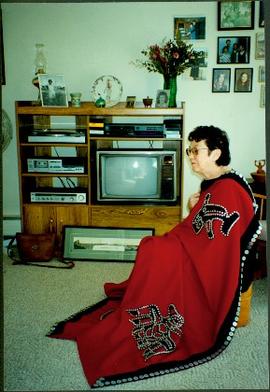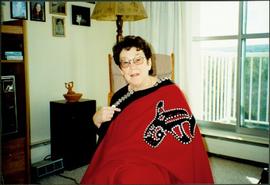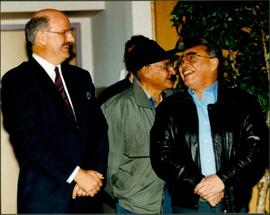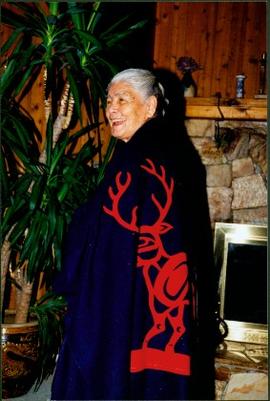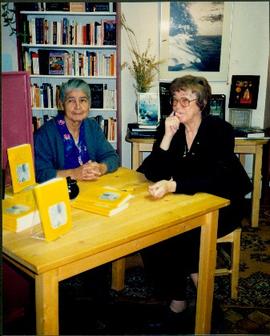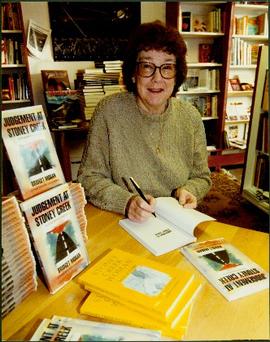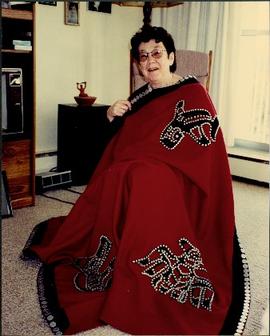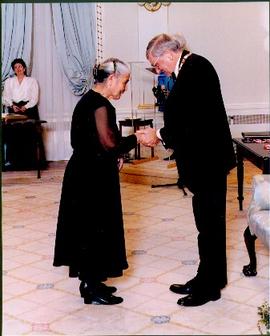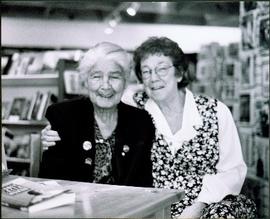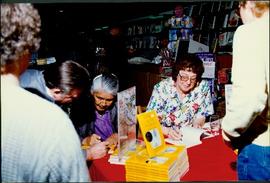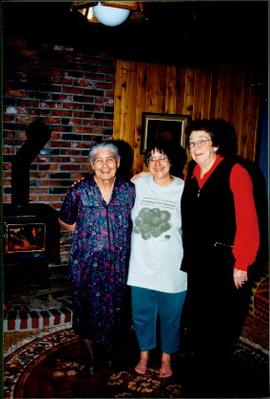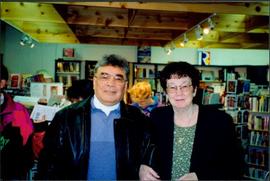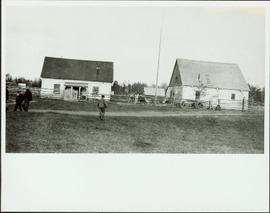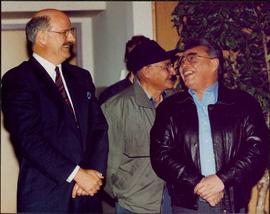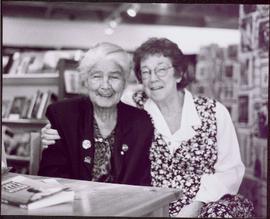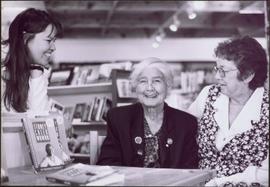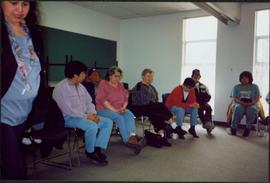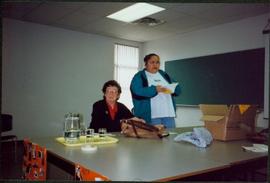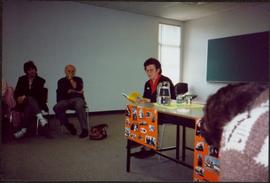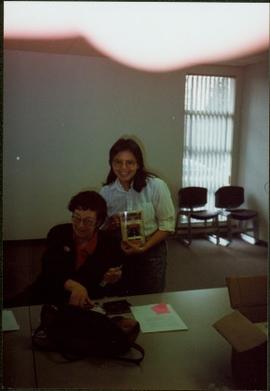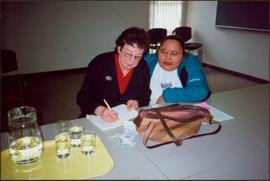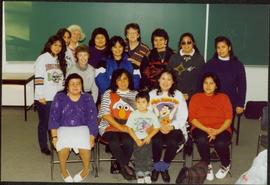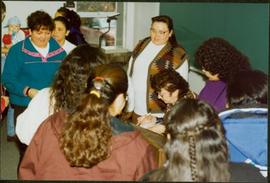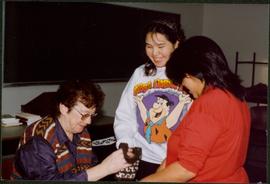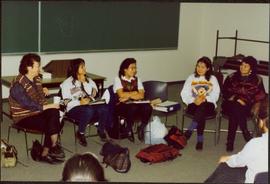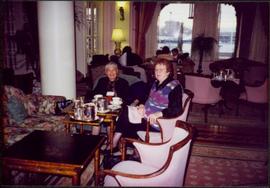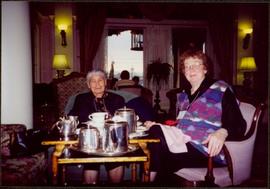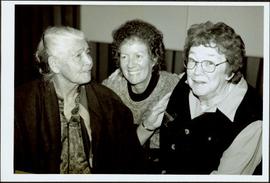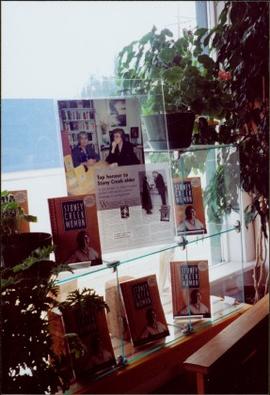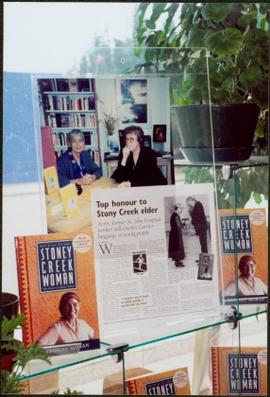Photograph depicts fishing territory at waterfall rapids in Bulkley River, B.C. Highway and buildings on opposite shore in background.
Close view of Mary John. Plant, couch, and window in background.
Photograph depicts Moran standing with unknown man in front of building with large wood beams in entryway (see also item 2008.3.1.22.25 for image featuring Moran with this young man).
Photograph depicts unidentified building with large wood beams in entryway.
Photograph depicts Moran walking away from round entrance to long house, unidentified individual visible inside.
Photograph depicts three unidentified individuals gathered around Justa Monk as he signs a copy of 'Justa: a First Nations Leader'. Plants and bookshelves in background.
Photograph depicts Justa Monk and Bridget Moran seated at table, signing copies of 'Justa: a First Nations Leader'. Crowd stands gathered around.
Photograph depicts Justa Monk and Bridget Moran seated at table, signing copies of 'Justa: a First Nations Leader'. Plants, bookshelves, and two unidentified individuals in background.
Photograph depicts Justa Monk and Bridget Moran seated in bookstore, bookshelves in background.
Photograph depicts Justa Monk and Bridget Moran seated at table, signing copies of 'Justa: a First Nations Leader'. The pair faces crowd standing in background. Windows and posters visible behind crowd.
Photograph depicts Moran standing in bookstore. Window, door, and plants in background. Photo taken at book signing event for Moran's 'Justa: a First Nations Leader'.
Close view of Bridget Moran seated to left of Mary John, both with a hand on the other's shoulder. Log wall in background.
Photograph depicts Justa Monk and Bridget Moran standing in bookstore. Unidentified woman and bookshelves in background.
Photograph depicts Justa Monk and Bridget Moran seated at table, signing copies of 'Justa: a First Nations Leader'. Plants, bookshelves, and unidentified man visible in background.
Photograph depicts Justa Monk and Bridget Moran seated at table, signing copies of 'Justa: a First Nations Leader'. Plants, bookshelves, two unidentified individuals also visible in image.
Photograph depicts Moran seated in chair at unknown location. Red and black button blanket features traditional thunderbird and killer whale designs. Television against wall in background.
Photograph depicts Moran seated in chair at unknown location. Red and black button blanket features traditional thunderbird and killer whale designs. Television, armchair, and window visible in background.
Photograph depicts Justa Monk standing to right of Premier Harcourt in unknown room. John Alexis can be seen between them in background.
Photograph depicts Mary John wearing long blue material with red caribou in traditional artwork on back. Plant and ornamented fireplace in background. Photo speculated to have been taken in Mary John's home.
Photograph depicts Mary John seated to left of Bridget Moran at book signing table. Copies of 'STONE CREEK WOMAN' displayed in foreground, plants and bookshelves in background.
Photograph depicts Bridget Moran seated at table covered with copies of 'Judgement at Stoney Creek'. Three copies of 'Stoney Creek Woman' are also displayed on table. Bookshelves in background. Photo believed to have been taken at same location as items 2008.3.1.17.1, 2008.3.1.17.2, and 2008.3.1.19.4.
Photograph depicts Moran seated in chair at unknown location. Red and black button blanket features traditional thunderbird, wolf, and killer whale designs. Television, armchair, and window visible in background.
Photograph depicts Mary John shaking hands with unidentified man at official ceremony where she was awarded the Order of Canada for outstanding service to her community. Two unidentified woman stand in background in large ornately furnished room.
Photograph depicts Moran with arm around Mary John, both seated at book display table. Bookshelves in background.
Photograph depicts Mary John seated to left of Bridget Moran at book signing table. Copies of 'STONE CREEK WOMAN' displayed in foreground. Three unidentified individuals stand gathered around table. Bookshelves and computer in background.
Unidentified woman stands between Mary John (on left) and Bridget Moran. Fireplace in background.
Justa Monk and Bridget Moran stand in foreground. Unidentified individuals can be seen in bookstore in background. Bridget Moran published a book in 1994 entitled 'Justa: A First Nations Leader, Dakelhne Butsowhudilhzulh'un'.
Photograph depicts two buildings behind fence, sheds visible in background. Unidentified men can be seen walking in foreground. Small structures believed to be teepees can be seen behind fence.
Photograph depicts Justa Monk standing to right of Premier Harcourt in unknown room. John Alexis can be seen between them in background. Handwritten annotation on recto of photograph: "Justa Monk / John Alexis Tachie Village / The Premier / Taken in Prince George, B.C. Jan 23/95 / 'The day Kemano 2 was killed'."
Photograph depicts Moran with arm around Mary John, both seated at book display table. Bookshelves in background.
Photograph depicts Moran seated to right of Mary John at table displaying copies of 'Stoney Creek Woman'. Unidentified woman stands on left, bookshelves can be seen in background.
Photograph depicts group of unidentified men and women seated in chairs in unknown classroom.
Photograph depicts Bridget Moran seated beside unidentified woman who stands reading excerpt from Moran's book. Table with miscellaneous items in foreground, window and chalkboard in background. (Standing woman also featured in item 2008.3.1.102.5).
Photograph depicts Moran reading excerpt from her book while seated beside table in classroom. Unidentified man and woman can be seen sitting in chairs against wall in background.
Photograph depicts unidentified woman holding copy of Moran's book, standing behind the author. Table in foreground, window and chairs in background.
Photograph depicts Moran seated to left of unidentified woman at table with glasses and pitcher of water. Window and chalkboard in background. (Woman also featured in item 2008.3.1.102.2).
Photograph depicts a young boy and group of fourteen women posed for photograph in classroom, chalkboard in background. Handwritten annotation on recto of photograph: "Aboriginal Women's Training Program, Cowichan Campus, Malaspina University College, Duncan BC".
Photograph depicts Moran seated amongst standing group of unidentified women. Overhead machine and chalkboard in background. Photograph was taken at session of Aboriginal Women's Training Program at the Cowichan Campus, Malaspina University College, in Duncan B.C.
Photograph depicts Moran seated to left of two students presenting small knitted craft. Desk and chalkboard in background. Photograph was taken at session of Aboriginal Women's Training Program at the Cowichan Campus, Malaspina University College, in Duncan B.C. Handwritten annotation on recto of photograph: "Gifts from Charlene + Joanne Smith".
Photograph depicts Moran seated on far left, in circle of women in classroom. Desk and chalkboard in background. Photograph was taken at session of Aboriginal Women's Training Program at the Cowichan Campus, Malaspina University College, in Duncan B.C.
Photograph depicts Mary John seated to left of Moran at table in large room with tables, chairs, and couches. Skyscraper and water visible through window in background. Accompanying note reads "Tea at the Empress! Feb/97"
Photograph depicts Mary John seated to left of Moran at table in large room with tables, chairs, and couches. Skyscrapers visible through window in background. Accompanying note reads "Tea at the Empress! Feb/97"
Close view of three women at unidentified location. Left to right: John, Hope, Moran.
Photograph depicts numerous copies of 'Stoney Creek Woman' (by Bridget Moran) in glass case. Display also features article on Mary John's receipt of the Order of Canada (see items 2008.3.1.22.61 and 2008.3.1.22.64 for photographs displayed in this image).
Photograph depicts numerous copies of 'Stoney Creek Woman' (by Bridget Moran) in glass case. Display also features article on Mary John's receipt of the Order of Canada (see items 2008.3.1.22.61 and 2008.3.1.22.64 for photographs displayed in this image).
Item is a recorded audio interview with Justa Monk.
Audiocassette Summary
00’10” Bridget Moran interviews Justa Monk. They discuss the ancestry of his last name and its original spelling, Monck. Moran wants to know more about Monk’s genealogy. She tells Justa his family history will be a chapter in the book.
08’ 45” Justa discusses how his ancestors move around on the land for hunting purposes. Moran wants to know more about gardens.
10’ 19” The interview returns to Justa’s family history, particularly the arranged marriage between his mother and father.
12’ 33” Moran asks about Justa’s immediate family. Justa talks about his brothers and sisters.
16’ 54” Justa talks about alcoholism with his brothers and sisters, and with other families.
20’ 10” Moran returns to asking about Justa’s brothers and sisters. Justa talks about one of his brothers being shot and killed; mentions the name of the man who killed his brother. Justa talks about his nephew getting shot by the RCMP.
27’ 54” Moran asks Justa about the relationship between him and his siblings. He talks about being the one who is reliable; has strong leadership skills, even though he is the youngest child.
30’ 50” Moran asks about Justa’s mother. She loved going to potlatches, did a lot of sewing. She was a very quiet and religious person. Justa’s father was the same, very outspoken. Justa tells Moran he is close to all of his brothers and sisters after she asks which he is closest. When Justa was 5 years old, he spent a lot of time with his father, where he learned to hunt by the age of 7.
34’ 20” Moran asks about Justa’s housing when he was growing up. He tells her his family had a large house, but there were no bedrooms, so they had different corners where they would sleep. They had a large garden outside of their home.
39’ 20” Justa talks about how isolated Portage was, so they had to grow their own food.
40’ 41” Moran asks about churches. Justa tells her there was a church and a priest came into Portage once in a while.
41’ 10” Moran asks about what Justa remembers about Christmas. He remembers getting dressed up and going to church to sing hymns.
43’ 02” Moran asks Justa which of his brothers and sisters went to school. Justa says his sisters were not punished or abused. His brothers enjoyed school. His brothers and sisters were not allowed to speak their language, and this was their only disappointment. Justa talks about his experiences at school; he quit school and tried to get a job.
50’ 24” Moran asks about when Justa moved from Portage to Tachie.
52’ 34” Moran asks about Justa trying to get a job at such a young age. He got a job with his brothers at a sawmill in Fort St. James.
55’ 33” Justa says he was born in 1943. Moran asks about when he met Theresa, his wife. They began their common-law relationship in 1966.
57’ 13” Moran asks about how long Justa was in jail. He served 9 months and was released on parole.
1:02’ 53” Justa talks about being unemployed and broke. Theresa came to visit him at camp where she stayed for 6 or 7 months. He talks about getting married later on in their relationship. Moran asks about where Theresa is from. Theresa is from Tachie but he did not know her growing up. Moran asks about Theresa’s background.
1:08’27” Justa talks about his many girlfriends, partying, and being a womanizer. Theresa and him got ‘serious’ after she had their daughter.
1:11’ 24” Moran ends the interview. She tells Justa they will change the pace for the next interview by discussing land claims. Moran asks Justa about running for chief. He lost the first time he ran.
1:14’28” Moran asks Justa about Kemano. Back in 1948, Kemano I was created. The Indian Agent came to the reserves for signatures so the Kemano project could go ahead. Justa says the people did not have time to move their things when the flooding began. People were misled with regards to what the Kemano project was about. People on the reserves were moved to Grassy Plains – they were spread out, not the same community as they were. In 1982, First Nations people began to fight back against Kemano II. Justa was a district chief.
1:24’ 48” Justa discusses the need for an environmental assessment for the Kemano project. The case to the Supreme Court and are currently waiting for the decision. The provincial government claims there is no need for environmental assessment and are planning to go forward with the project. Justa discusses the commission and the Kemano case, in general.
1:30’ 07” End of tape.
Item is a recorded audio interview with Justa Monk.
Audiocassette Summary
00’ 10” Continuation of Tape 2. Justa discusses the review of the Kemano project. He wants a public review where there is First Nations representation. He is frustrated by the lack of a working relationship and being recognized as a leader.
03’ 29” Their way of life is damaged from the flooding. Graveyards were flooded in the 1940s. Fishing grounds will never be the same. Kemano II will do the same damage to a narrower piece of land. Seven communities will be affected, particularly Stoney Creek, because there will be no more fishing grounds.
08’ 27” They are doing this for more electricity, not for the aluminum. BC Hydro made a deal with Alcan for a bigger reservoir. Moran asks Justa if BC Hydro is the ‘imp in the woodpile.’ Justa tells her there is a three-party agreement between Alcan, BC Hydro, and the provincial government. He tells her the project will not go ahead because he believes the Supreme Court will rule in their favour.
15’ 05” Moran mentions Mary John saying that everything the First Nations ‘ever got they had to fight for.’ They briefly discuss Oka. Justa returns to discussing the Kemano II project.
16’ 53” Moran asks Justa about the Aluminum Company of Canada.
17’ 49” They both talk about the Indian Agent that would not let First Nations people in his home. They both relay their disgust with a specific Indian Agent.
18’ 41” Moran asks Justa about the Carrier-Sekani land claims. He discusses having to revisit the boundary lines. Justa talks about an agreement he signed on September 21, 1992, where there would be proper representation for the First Nations people.
26’ 30” Justa discusses the ‘potlatch law’ which he describes as ‘love, share, and respect.’ He talks about how he often gets a good response from groups he teaches.
34’ 51” Moran tells Justa how she was contacted by the Stoney Creek Band regarding how they collected several stories that are unreadable. They have asked Moran to somehow transcribe them properly.
36’ 37” Moran asks Justa about the Kemano II decision from the Supreme Court. He talks about how he is disappointed in the decision, but said he expected it because the government has rarely ruled in favour of First Nations issues.
43’ 16” Justa tells Moran that he was written a letter to President Bill Clinton and Vice-President Al Gore extending an open invitation to see the damage the Kemano II project has done to the environment.
45’ 03” Moran asks Justa when he returned to Tachie to work. He discusses his work there. In 1969, he began work at BC Rail. He moved to Dawson Creek with Theresa and their family.
51’ 09” Moran asks Justa about returning to the village of Tachie, particularly with the trouble that had happened with his brother. He talks about how the elders believed that everything would work out and how many of his achievements relate to that philosophy.
54’ 37” Moran asks Justa about his maintenance work for BC Rail. He describes his position in detail.
59’ 44” Moran asks Justa about the great gardens his father had grown, but this has stopped because of the road. He talks about bringing in television to the community. He talks about when hydro came into the community in the early 1970s. He talks about the water and sewage system being implemented in the mid-1970s.
1:05’ 10” Justa talks about when he became band manager in 1973. He describes his position. Moran asks about the difference between band manager and chief. Justa describes the difference.
1:13’ 21” Moran asks about whether or not Justa had to deal with Indian Agents or the DIA during that time. He describes his band manager position further as being a marriage counsellor, policeman, secretary, a bouncer, and always trying to make peace within the community. He talks about the pressure of the position, and how it made his alcoholism worse, how he was on sleeping and nerve pills.
1:21’ 31” Moran asks about the population of Tachie. She asks about the location of Grand Rapids.
1:22’ 33” Justa talks about becoming chief in 1975, but also kept the band manager position. He discusses in detail about being both, particularly with social issues. He talks about how parties often ended up in some accident ie a little girl getting shot.
1:28’ 34” Moran asks about the isolation of the community. Justa discusses calling for a boat or a plane to evacuate someone in case of an emergency.
1:30’ 10” End of tape.
Item is a recorded audio interview with Justa Monk.
Audiocassette Summary
00’ 10” Justa talks about getting together a memorandum of understanding regarding boundaries for fishing grounds. Justa has also been discussing land claims with the provincial government. He talks about setting up the future for the younger generation. He says a fair land claim settlement would be the granting of traditional grounds.
5’ 27” Moran asks about the Save The River campaign.
6’ 14” Moran inquires about the diaries Justa is supposed to bring her. Justa wants to talk about his childhood. He feels his youth was better than the youth of today because they are given everything.
11’ 06” Moran asks about Justa’s life in Portage and to describe a day he remembers from his time there before going to residential school. He talks about not being allowed out after dark and being respectful of other people’s property. He discusses being disciplined by talking about what was right and wrong.
15’ 15” Justa talks about his time in residential school and how he was not allowed to speak his native language. He was shocked by the corporal punishment. Moran and Justa discuss about putting this in the book or not. He talks about not having any privacy in the residential school.
21’ 55” They return to discussing the personal details of Justa’s life in Portage, such as eating porridge for breakfast. Moran and Justa discuss fishing and hunting, and the times of the year he would be away from home.
27’ 55” Moran asks Justa about a day at the residential school. He talks about how he refused to buy a Bible. He participated in sports in his second year. He talks about the food and having to take cod liver oil. He talks about being a hockey player. He talks about the time he broke his leg at the residential school.
37’ 51” Moran asks Justa about which of his sisters would be willing to talk to her. They begin to talk about Justa’s philandering and how he had a lot of fun during that time. He talks about cheating on Theresa, but they stayed together. They continue to talk about his sex life. He talks about his relationship with Theresa. He talks about his daughter, Sharon.
47’ 00” Moran wants to talk about the trauma of John, his brother who was murdered. He tells Moran that was the time he started to turn his life around. They talk about his time in jail.
48’ 18” Moran starts the interview with Theresa, Justa’s wife. Moran asks Theresa about her personal details. She talks about her family past. She got married to get away from her parents, who were her adoptive parents.
52’ 40” Moran asks Theresa about going to residential school and how her parents would not allow it because they wanted to teach other responsibilities. Theresa talks about how some of her responsibilities were hunting beavers.
59’ 30” Theresa starts talking about how she found out she was adopted. She discusses her real brothers and sisters and how several of them passed away from tuberculosis. She talks about how she is close to her adoptive mother. Theresa does not know why she was adopted out.
1:05” 57” Moran asks Theresa about residential school. Theresa says she could not speak English, so was punished for speaking her native language. She says there was no corporal punishment against her. She talks about getting tuberculosis and getting transferred to a hospital where she stayed for eighteen months. She learned how to speak English while at the hospital.
1: 14’ 57” Theresa talks about getting married at the age of 18 in 1948. Theresa gets tuberculosis again in 1956, so was placed in a sanatorium. She returns to talking about her former husband and how he treated her poorly. He was sent to jail for about two years for assaulting Theresa.
1: 26’ 50” Theresa talks about how difficult it was to obtain money for her and the children.
1: 27’ 54” Moran asks about how she met Justa. She says she always liked him and thought he looked cute. She began to go out with Justa in the 1960s. She moved to Dawson Creek to be with Justa when he was released from jail.
1:33’ 35” End of tape.
Item is a audio interview recorded by Bridget Moran with Jimmy, Rosie, Nancy, and Madeline.
Audiocassette Summary
00’ 05” Continuation of interview with Jimmy. Jimmy says his grandfather is French, not German, like Justa thinks. Moran and Jimmy continue to talk about the history of his grandparents. Jimmy continues to talk about his family history. They talk about the history of their last name, Monk.
12’ 08” Interview changes to Rosie. Moran asks Rosie about her siblings and other family history. Moran asks about the history of their last name, Monk. She believes her descendants are French. They continue to talk about her family history.
19: 22” Moran asks Rosie about the time Justa murdered John. Rosie talks about the situation candidly. She talks about John’s family life.
26’ 30” Moran asks Rosie about attending residential school. Rosie says school was alright for her, that they looked after them. She came home after six years.
28’ 30” Rosie talks about traveling around with her father because he worked many different jobs.
29’ 55” Rosie talks about getting married, how she got to choose her own partner, instead of having it arranged. She discusses her children.
32’ 05” Moran asks if Rosie had a good childhood. Rosie says yes, but her parents were strict. She remembers her father having to pay a land tax because they did not live on reserve land. She continues to talk about her childhood.
37’ 16” Rosie talks about life in residential school. Nancy says the nuns were kind; that they had to punish them if they spoke their native language.
38’ 50” Interview changes to Nancy. Moran asks about the history of their last name, Monk. They talk about her family history.
45’ 43” Moran asks Nancy about the time Justa killed his brother, John. Nancy talks about what she can remember.
47’ 32” Moran asks Nancy about the death of her brother, Teddy. She tells Moran the story she was told by the police.
49’ 34” Moran asks Nancy when she went to residential school. Nancy talks about having convulsions, so only spent two years there, then came home. When she was feeling better, she went back for another two years. She said her time there was not that bad, but she was homesick and lonely.
53’ 16” Moran asks Nancy if she had a good childhood. Nancy tells her she did, that they did everything for their parents.
56’ 07” Interview changes to Madeline. Moran asks about the history of their last name, Monk. Madeline does not know much about it. They continue to talk about the history of the family.
1:02’ 45” Madeline tells Moran about how she knocked Justa out with a block of ice because he was teasing her when they were children. Justa was a big tease, she says. Madeline says that Justa collected a box full of ‘treasure.’
1:09’ 10” Moran asks Madeline about her mother and how much she sewed for other people.
1: 10’ 44” Moran asks about when Madeline went to residential school. She tells Moran that she liked it there. Those who went there have discipline, she says.
1: 12’ 55” Madeline tells Moran that her parents were strict. She talks about being punished when breaking the rules, much like being at the residential school. They return to discussing residential school.
1: 17’ 55” Moran asks Madeline about what she remembers about the trips between Portage and Fort St. James. She talks about traveling by canoe once with her grandfather.
1: 20’ 33” Moran tells Madeline what she plans to write about in the book, particularly the first chapter dealing with the family history and life before the road being built to Portage.
1: 23’ 25” They return to talking about the family history, including aunts. They talk about her siblings.
1:30’ 07” Moran asks about Justa Hanson, the man Justa was named after. He was living in Tachie at the time Justa was born.
1:32’ 40” End of tape.
Item is a audio interview recorded by Bridget Moran with Justa Monk.
Audiocassette Summary
00’ 10” Moran asks Justa about living ‘three lives.’ Justa discusses the three phases of his life – childhood, getting in trouble, and being in a leadership role.
03’ 10” Moran asks Justa to discuss his older brother John. Justa talks about John and his personality and his relationships.
07’ 35” Justa discusses the trouble he got into with John. Justa does not remember what started the fight, because no one wanted to tell him what had happened. Justa does not remember killing his brother, but discusses how he wanted to commit suicide after finding out the truth. Justa also talks about his jail time.
24’ 14” Justa talks about his move to Dawson Creek to do upgrading. He still had the intention of Justa talks about adopting his niece.
26’ 03” They return to discussing Justa’s committing suicide. He felt guilty about taking his brother’s life. They also discuss his alcoholism.
35’ 25” Moran asks Justa about how he felt about being Indian or being treated as a second-class citizen. Justa says he is proud to be Indian.
38’ 35” Justa talks about being slapped as punishment for using his native language at school. He talks about kissing a girl and getting caught. He talks about his other punishments at residential school, and how he got tired of a specific teacher. He continues to discuss the school and assimilation into the ‘white world.’
53’ 35” Moran asks about the name he was named after, Justa Hansen, who was from Tachie. Justa talks about how Hansen was an important leader of the community.
55’ 52” Moran asks about ‘Indian’ food, such as deer, bear meat and salmon. He loves this type of food dried.
58’ 49” Moran asks Justa when he became tribal chief. He talks about the history of the position and how he became the tribal chief.
1: 03’ 30” Moran asks about Justa’s father’s potlatch. He talks about his parents’ death.
1: 07’ 17” End of tape.
